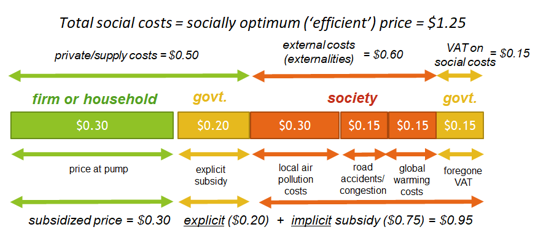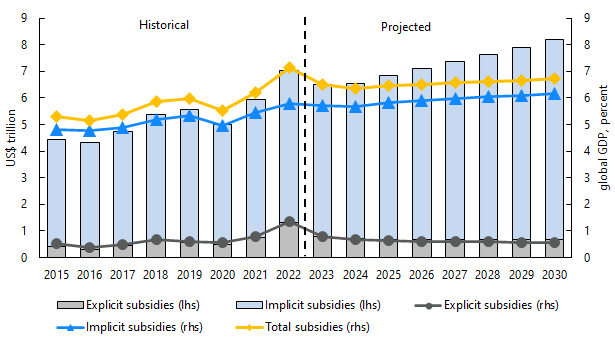Fossil Fuel Subsidies
Why do we care about fossil fuel subsidies?
Subsidies are intended to protect consumers by keeping prices low, but they come at a substantial cost. Subsidies have sizable fiscal consequences (leading to higher taxes/borrowing or lower spending), promote inefficient allocation of an economy’s resources (hindering growth), encourage pollution (contributing to climate change and premature deaths from local air pollution), and are not well targeted at the poor (mostly benefiting higher income households). Removing subsidies and using the revenue gain for better targeted social spending, reductions in inefficient taxes, and productive investments can promote sustainable and equitable outcomes. Fossil fuel subsidy removal would also reduce energy security concerns related to volatile fossil fuel supplies.
Measuring Fossil Fuel Subsidies
Subsidies are decomposed into explicit and implicit subsidies. Explicit subsidies occur when the retail price is below a fuel’s supply cost. For a non-tradable product (e.g., electricity), the supply cost is the domestic production cost, inclusive of any costs to deliver the energy to the consumer, such as distribution costs and margins. In contrast, for an internationally tradable product (e.g., oil), the supply cost is the opportunity cost of consuming the product domestically rather than selling it abroad plus any costs to deliver the energy to the consumer. Explicit subsidies also include direct support to producers, such as accelerated depreciation, but these are relatively small.
Implicit subsidies occur when the retail price fails to include external costs, inclusive of the standard consumption tax. External costs include contributions to climate change through greenhouse gas emissions, local health damages (primarily pre-mature deaths) through the release of harmful local pollutants like fine particulates, and traffic congestion and accident externalities associated with the use of road fuels. Getting energy prices right involves reflecting these adverse effects on society in prices and applying general consumption taxes when fuels are consumed by household.
In the example below, the retail price for gasoline is $0.30 per liter, while the supply cost is $0.50 per liter (inclusive of VAT), total external costs are $0.60 per liter, and the value-added tax (VAT) rate on gasoline is equal to the standard rate of 14 percent. Thus, the explicit subsidy is $0.20 per liter and the implicit subsidy is $0.75 per liter ($0.60 in undercharging for external costs and $0.15 per liter due to the VAT base including all social costs). If national consumption of gasoline is 100 million liters, then the total subsidy is ~$475 million ($100 and ~$375 million from explicit and implicit, respectively).

The below figure shows estimates of current and efficient fuel prices of major fuels for all the Group of Twenty (G20) countries and selected other countries in 2021-22. Retail prices generally cover the supply costs but rarely environmental costs, with the largest price gaps generally for coal, followed by diesel, diesel, and gasoline. Coal has the largest external costs due to significant emissions of greenhouse gas and harmful local air pollutants, while road fuel use results in large congestion and accident costs. Natural gas is relatively less polluting, but also rarely taxed.
Size of Fossil Fuel Subsidies
Globally, fossil fuel subsidies were $7 trillion or 7.1 percent of GDP in 2022, reflecting a $2 trillion increase since 2020 due to government support from surging energy prices. Subsidies are expected to decline in the near-term as energy price support policies is unwound and international prices fall, but then rise to $8.2 trillion by 2030 as the share of fuel consumption in emerging markets (where price gaps are generally larger) continues to climb. 18 percent of the 2022 subsidy reflects undercharging for supply costs (explicit subsidies) and 82 percent for undercharging for environmental costs and forgone consumption taxes (implicit subsidies), with the share of explicit falling to 8 percent by 2030.

Underpricing for local air pollution costs and climate damages are the largest contributor to global fossil fuel subsidies, accounting for about 30 percent each, followed by explicit subsidies (18 percent), broader road transport externalities such as congestion and road accidents (17 percent), and forgone consumption tax revenue (5 percent). Explicit subsidies are broadly found in the Middle East and North Africa (MENA), Europe, Commonwealth of Independent States (CIS), and East Asia and Pacific (EAP) while total (explicit plus implicit) subsidies are predominately in the EAP. Relative to regional GDP however, total subsidies for Europe and North American are smallest at about 3 percent, while subsidies are 23 percent of regional GDP in CIS and 19, 10, and 10 percent respectively in MENA, South Asia and EAP. From 2020 to 2022, subsidies increased substantially in all regions except North America.
Impacts of Subsidy Reform
Raising fuel prices to their fully efficient levels reduces projected global fossil fuel CO2 emissions 43 percent below baseline levels in 2030—or 34 percent below 2019 emissions. This reduction is in line with the 25-50 percent reduction in global GHGs below 2019 levels needed by 2030 to be on track with containing global warming to the Paris goal of 1.5-2C. Globally, around 60 percent of the CO2 reduction comes from reduced use of coal, while 30 and 10 percent respectively are from reductions in consumption of petroleum and natural gas. Removing only explicit subsidies reduces emissions to 5 percent below the baseline, while a partial price reform of halving the gap between current and efficient prices reduces emissions 31 percent.

Full price reform raises revenues of $4.4 trillion, 3.6 percent of global GDP, in 2030 (relative to baseline levels and accounting for revenue losses due to erosion of pre-existing fuel tax bases). Revenue gains vary substantially across regions, largely mirroring the distribution of (explicit and implicit) subsidies. The revenues generated by full price reform in 121 EME and developing countries in 2030 would amount to $3 trillion, which is broadly in line with their additional spending needs for Sustainable Development Goals. A partial price reform results in about two-thirds of the revenue gain.

Reform Efforts
In 2009, the Group of 20 advanced and emerging market economies called for a phase out of inefficient fossil fuel subsidies in all countries and reaffirmed this again in 2012. At COP26 and 27 in 2021 and 2022, countries agreed to accelerate efforts to phase-out inefficient fossil fuel subsidies.
Several countries have succeeded in removing explicit subsidies and/or phasing in taxes and other pricing measures to cover external costs. A few examples include the EU Emissions Trading Scheme, which forces power plants and industrial sources to pay for carbon emissions and had prices slightly above a warming target-consistent carbon price in 2022; India, Morocco, Saudi Arabia, and Ukraine that have phased-out explicit subsidies and, in some cases, introduced taxes; and the numerous countries that tax road transportation use (over 160 globally).
Still, many countries have had difficulty reforming subsidies despite the potential gains. When reforms are made, prices increase, and this can lead to social unrest. The absence of public support for subsidy reform is in part due to a lack of confidence in government’s ability to compensate the poor and middle class for the higher energy prices they face. Governments are also often concerned that higher energy prices will contribute to a higher rate of inflation and adversely affect their competitiveness. Subsidy reform can also be complex when it includes efforts to reduce inefficiencies and production costs, as is often the case for the electricity sector.
A Plan for Reform
While there is no single recipe for successful subsidy reform, country experiences suggest that the following ingredients are needed:
- A comprehensive energy sector reform plan with clear long-term objectives with an analysis of the impact of reforms;
- Transparent and extensive communication and consultation with stakeholders, including information on the size of subsidies and how they affect the government’s budget;
- Price increases that are phased-in;
- Improving the efficiency in state-owned enterprises to reduce producer subsidies;
- Measures to protect the poor through targeted cash or near-cash transfers or, if this option is not feasible, a focus on existing targeted programs that can be expanded quickly; and
- Institutional reforms that depoliticize energy pricing, such as the introduction of automatic pricing mechanisms.










